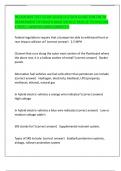Exam (elaborations)
Test Bank Davis Advantage for Pediatric Nursing The Critical Components of Nursing Care Second Edition by Kathryn Rudd 9780803666535 Chapter 1-22 | Complete Guide A+
- Course
- NURSING 3425
- Institution
- University Of Colorado Colorado Springs
Test Bank for Pediatric Nursing : The Critical Components of Nursing Care, 2nd Edition, Kathryn Rudd, Diane Kocisko Table of Contents Pediatric Nursing: An Overview 1. Issues and Trends in Pediatric Nursing 2. Standards of Practice and Ethical Considerations Psycho-Social-Cultural Assessment of the...
[Show more]












